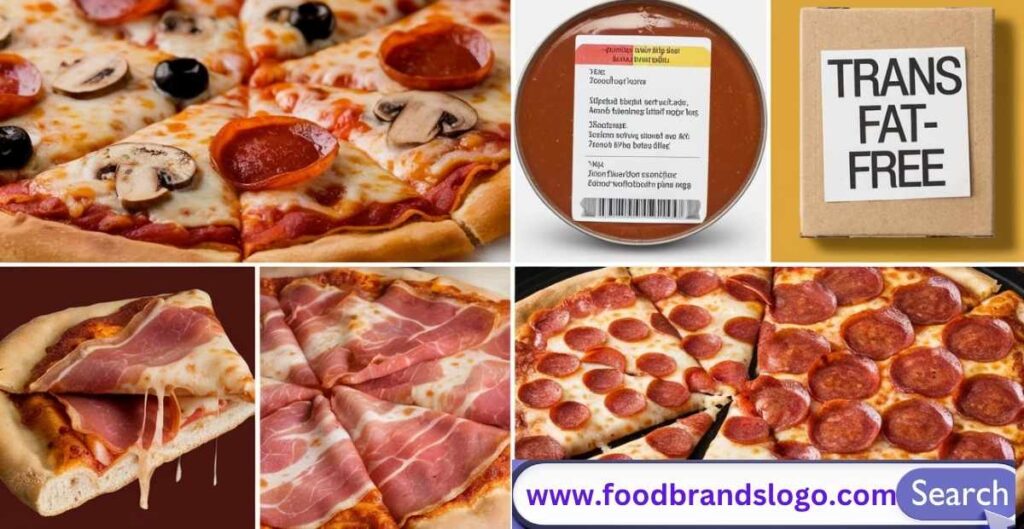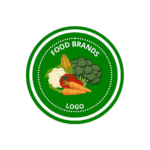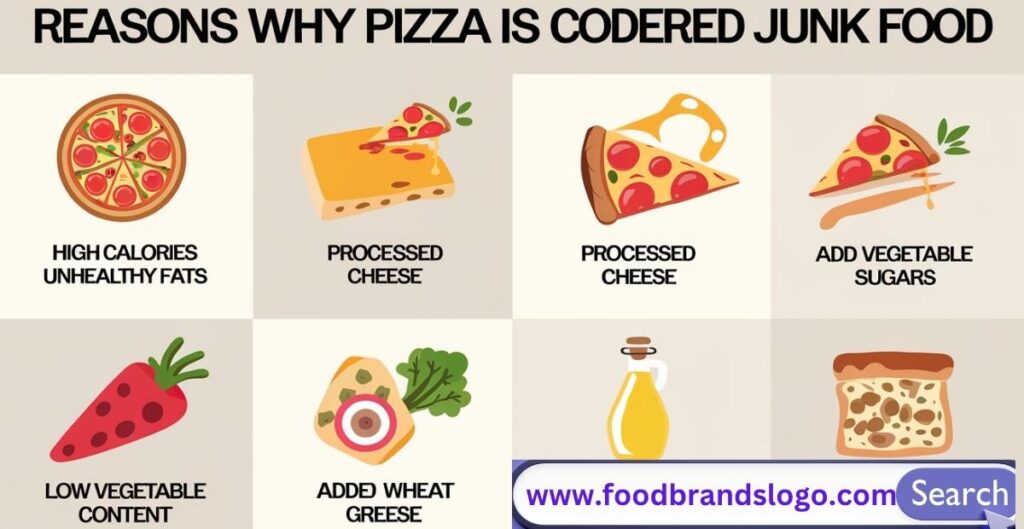Introduction
Everyone love pizza? It is comfort food—cheesy, crispy, savory, and endlessly manageable. As a classy slice of pepperoni to a gourmet Margherita topped with basil and olive oil, pizza has become a favorite global. Unless its popularity, one question continues to come up: why is pizza considered junk food?
In this comprehensive blog post, we shall dive into what qualifies pizza as junk food, analyze its nutritional makeup, reveal six compelling reasons it is mostly labeled unhealthy, and offer smarter ways to enjoy it. By the end, you’ll not only understand the pizza-health debate but also learn how to make your slices a bit more balanced.
What Is Junk Food, And Where Does Pizza Fit In?

To answer “why is pizza considered junk food?”, we first need to define what junk food actually mean. In short, junk food refers to food that’s high in calories but low in essential nutrients. It usually contains excessive amounts of sugar, sodium, unhealthy fats, and refined ingredients. Think potato chips, soda, candy bars—and yes, in many cases, pizza.
So, how does pizza fit in?
Pizza checks many of the junk food boxes when it’s made with:
- Refined white flour crust
- Processed meats like pepperoni and sausage
- Heavy cheese loaded with saturated fat
- High sodium levels from sauces and toppings
This is specially true that fast food pizza from major chains like Pizza Hut, Domino’s, and Little Caesars, which likely prioritize taste and shelf life over nutritional values. While not all pizza is automatically junk food, the most common versions are.
The Nutritional Breakdown of Pizza
Let’s take a closer look at a typical fast-food pizza slice:
| Nutrient | Average per slice (pepperoni, 14” pizza) |
|---|---|
| Calories | 285–350 |
| Saturated fat | 5–7 grams |
| Sodium | 700–900 mg |
| Carbs | 35–40 grams |
| Protein | 12–15 grams |
| Sugar | 2–4 grams |
| Fiber | 1–2 grams |
At first sight, it may not look too risky. But take it in mind, mostly people don’t stop at just single slice. Two to three slices, paired with sugary soda or cheesy breadsticks, can skyrocket your calorie intake to over 1,000 in one sitting. Combine that with a lack of fiber, vitamins, or antioxidants, and you’ve got a clear junk food profile.
6 Reasons Why Pizza Is Bad for You
Let’s break down exactly why pizza is considered junk food and how it impacts your health.
1. High in Saturated Fats
The cheese—arguably the star of any pizza—is often loaded with saturated fats. Add meat toppings like sausage, bacon, or pepperoni, and you’re stacking even more fat onto your slice.
Why does this matter?
- Diets high in saturated fats have been linked to heart disease, high cholesterol, and obesity.
- One slice can contain up to 35% of your daily saturated fat limit.
Cheese lovers, beware—too much of a good thing can lead to clogged arteries and long-term health issues.
2. Loaded with Sodium
Most commercial pizza is a sodium bomb. From the salty dough to processed meats and even canned tomato sauce, sodium levels can quickly get out of control.
- Excess sodium is directly tied to high blood pressure and cardiovascular strain.
- A three-slice meal can exceed your recommended daily sodium intake of 2,300 mg.
This makes pizza particularly risky for people with hypertension or kidney issues.
3. Refined Flour in the Crust
That crispy, chewy crust? It’s usually made with refined white flour, which has been stripped of fiber and nutrients during processing.
Why is that a problem?
- Refined carbs can spike your blood sugar quickly, followed by an energy crash.
- They offer little to no nutritional benefit, which means they’re just empty calories.
In contrast, a whole wheat or cauliflower crust offers more fiber, better digestion, and improved satiety.
4. Processed Meats and Additives
Pizza’s most popular toppings—pepperoni, sausage, ham—are all processed meats. These are preserved with nitrates, chemicals, and artificial flavor enhancers, which aren’t doing your body any favors.
According to the World Health Organization:
- Processed meats are classified as Group 1 carcinogens—the same category as tobacco and asbestos.
- Regular consumption is linked to colon cancer, heart disease, and increased inflammation.
Plus, processed meats increase the calorie density and fat load of your pizza without adding much nutrition.
5. Excess Calories in One Sitting
Let’s do not be unfair: pizza is one of those foods that’s hard to eat in moderation. The average person eats 2–4 slices in a sitting, which can amount to:
- 800–1,400 calories
- 35–50 grams of fat
- 100+ grams of refined carbs
And Without considering extras like soda, dips, or desserts. The portion distortion is real—and it’s a fast track to weight gain when eaten frequently.
6. Nutrient Deficiency
The final nail in the junk food coffin is this: most pizza doesn’t nourish your body.
It’s low in:
- Vitamins (especially A, C, D, E, and K)
- Minerals (like magnesium, potassium, and zinc)
- Fiber, which supports digestion and gut health
This is the reason that makes pizza a “nutrient-poor” or energy-dense but nutrition-light meal, especially if consumed often.
Is Pizza Junk Food or Fast Food?
This is a common question. Let’s clear it up:
- Fast food pizza is almost always junk food due to its preparation, ingredients, and portion sizes.
- Homemade or artisanal pizza can be healthier, depending on how it’s made.
Fast food is typically:
- Quick and convenient
- Mass-produced and standardized
- Made with cost-saving ingredients
So, most fast food pizza, whether you take a slice from Domino’s or your local pizza hut, falls under the junk food umbrella. But not all pizzas has to be junk.
Homemade vs. Commercial Pizza: Is Homemade Pizza Junk Food Too?
Homemade pizza gives you control over ingredients. It can shift from “junk food” to “balanced meal” with a few thoughtful choices:
- Use a whole wheat or cauliflower crust.
- Opt for low-fat cheese or go easy on the amount.
- Choose lean proteins like grilled chicken or legumes.
- Load up on fresh veggies: bell peppers, mushrooms, spinach, onions, zucchini.
- Use homemade tomato sauce with olive oil, garlic, and herbs.
while making your pizza at home, you ditch most of the processed, high-sodium, and calorie-heavy pitfalls of restaurant versions.
Is Italian Pizza Junk Food?
Italian pizza—especially traditional Neapolitan or Roman-style pizza—differs significantly from American fast food pizza:
- Thin crust made with simple, fresh dough
- Minimal cheese, often just fresh mozzarella
- Fresh tomato sauce, not overly sweet or salty
- Light toppings, like basil, olive oil, or veggies
The above pizza is mostly eaten in reasonable portions and made with whole ingredients, making it less junky and more balanced diet. It is still indulgent, but far from the calorie-heavy, meat-loaded versions from American chains.
How Pizza Compares to Other Fast Foods
Let’s stack pizza up against some fast food rivals:
| Food | Average Calories | Sodium | Fat | Protein |
|---|---|---|---|---|
| Pepperoni Pizza (3 slices) | 900–1,050 | 2,400 mg | 40g | 36g |
| Cheeseburger w/ Fries | 950–1,200 | 1,800 mg | 50g | 30g |
| Fried Chicken Sandwich | 800–1,000 | 1,700 mg | 35g | 30g |
| Burrito (Fast Casual) | 1,000–1,300 | 2,000 mg | 35g | 40g |
Pizza exceeds other fast foods in terms of calories and sodium. It might be lighter than a burger or fried chicken, but portion size tricks you into eating more than you considered.
Many Items of Junk Food Contain Few Nutrients
Pizza isn’t alone in this. The broader category of junk food also includes:
- Candy
- Ice cream
- French fries
- Sugary cereals
- Soda
What they all have in common:
- High in calories, fat, sugar, and/or sodium
- Low in essential nutrients
- Easy to overeat
- Highly processed and shelf-stable
Pizza can be in this list while it follows the same formula—but it can break free with healthier ingredients and better portion control.
Can You Enjoy Pizza Without the Junk?
Absolutely yes. Here is the way you can enjoy pizza with no junk food:
Healthier Pizza Tips:
- Switch the crust: Use whole wheat, almond flour, or cauliflower crusts.
- Go light on cheese: Use part-skim mozzarella, vegan cheese, or even a sprinkle of parmesan.
- Add more veggies: Bell peppers, spinach, mushrooms, arugula, tomatoes—pile them on.
- Choose lean proteins: Skip the pepperoni and bacon; try grilled chicken, tofu, or beans.
- Watch your portions: 1–2 slices with a side salad is usually plenty.
- Make it at home: DIY pizza means fewer preservatives, better ingredients, and full control.
Pizza is not a junk food, it is just to be made smarter.
Conclusion
Now think how pizza is considered as junk food? The short answer is that most of the time pizza contains high calories, saturated fat, sodium, and processed ingredients and most of the time lack of essential ingredients.
But it is not all bad news. But With a few simple steps, pizza can be shift from a junk food to a balanced, delicious part of your diet. Whether you are enjoying a thin crust Neapolitan slice in Italy or baking a veggie loaded pie at home, it is all about ingredients, moderation, and awareness.
Do not give up your love for pizza. just improve it.
FAQs
Is all pizza considered junk food?
Not necessarily. While most fast food or frozen pizzas are considered junk food due to their high fat, sodium, and refined ingredients, homemade or traditional-style pizzas with fresh, whole ingredients can be much healthier. It all depends on how the pizza is made and what goes into it.
Can pizza be part of a healthy diet?
Yes, pizza can be part of a balanced diet if you make mindful choices. Opt for whole wheat or cauliflower crusts, lean protein toppings, and plenty of vegetables. Limiting portion sizes and pairing your pizza with a salad can also help balance your meal.
Why is pizza high in calories?
Pizza is calorie-dense because it combines refined flour, cheese (often high in fat), processed meats, and rich sauces. Eating multiple slices adds up quickly, especially if you’re eating stuffed crusts or deep-dish versions.
What are the worst ingredients in junk food pizza?
The main offenders are processed meats like pepperoni or sausage, excess cheese, refined white flour in the crust, and salty sauces. These ingredients contribute to high levels of saturated fat, sodium, and calories while offering little nutritional value.
How can I make my pizza healthier at home?
Start by using a whole grain or vegetable-based crust. Use less cheese or opt for a lower-fat version. Choose lean proteins like grilled chicken or go meatless with legumes. Load up on veggies, use homemade tomato sauce, and drizzle a bit of olive oil instead of greasy toppings.

